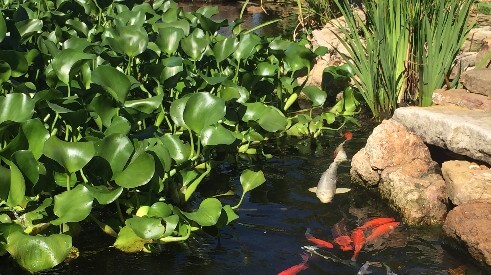Koi and Garden Pond Water Quality

Low Maintenance Koi Ponds, Fish Ponds, and Water Gardens
Low maintenance fish ponds, koi ponds, water gardens, and garden ponds can be setup easily with the following: a pond filter system, beneficial bacteria, a pond test kit, tap water conditioner, a barley product, pH decreaser, phosphate remover, and pond plants. With that said, a fish pond does not need pond filter per-say, but, if a fish pond or koi pond does not have a pond filter, then the pond will go through periods of murkiness and green pond algae as the pond plants struggle to contain the dynamic force named mother nature. It is very difficult to keep a pond clean, healthy, and clear without a pond filter.
A pond filter’s main purpose is to keep the pond fish healthy by establishing a beneficial bacterial colony that converts fish waste into harmless water components. In smaller pond filters that do not have mechanical and biological filter media, it is critical not to clean the filter media with tap water because it kills off the beneficial bacteria in the pond filter. In pond filters that have mechanical and biological filter media, the filter pads can be hosed off with tap water because the beneficial bacteria grows within the biological filter media. Only clean the biological filter media when absolutely necessary and preferably in early spring or late fall.

A backyard pond, koi pond, or water garden is a little world and eco-system we created that may need our help occasionally to achieve the natural balance necessary to sustain pond life and healthy pond fish. This is usually not difficult.
It is very important to eliminate chlorine and other metals from tap water when filling the pond. There are many articles and videos claiming adding little bits of chlorinated water here and there to the pond does not hurt koi and goldfish. However, these are the same folks that attribute fish loss to a faulty pump or hot weather. Metal is to koi and goldfish gills what cigarette smoke is to human lungs. After adding small of amounts of untreated water to koi and goldfish ponds over a period of time damages fish gills. If there is an oxygen problem for any reason after damage to gills from chlorine is done, the result is fish loss whereas healthy fish can tolerate an oxygen deficiency for quite some time. There are many cost effective brands of dechlorinator, tap water conditioner, and chlorine remover that are very easy to use. We have a Concentrated Water Conditioner that is an all natural and concentrated tap water conditioner. For water changes, pond clean outs, and when a lot of tap water has to be added to the pond, we recommend our all natural Koi TLC.
With that said, we are all guilty of overstocking our ponds with pond fish because there is always “that one fish” that we really do not need, but, we really want it! Overstocked ponds are also ponds that have overfed fish. Over abundances of pond fish food and too many fish can have oxygen problems that our pond pumps and waterfalls cannot overcome without the use of an aeration kit.
Achieving Pond Balance is a Maintenance Free Koi Pond

Achieving a healthy pond with clear water and very little maintenance is quite possible without spending a lot of time and money. As a general rule of thumb, filtration systems and the need for aquatic pond plants are disproportional in that the more sophisticated the filter system, the less the koi pond will depend on pond plants for clean and clear water. Therefore, if a koi pond or garden pond has a relatively simple pond filter and/or a pond filter that is sized according to the gallons in the pond, and it has very few pond plants, the koi pond, goldfish pond, or water garden will struggle with regards to clear water. Conversely, ponds that have a pond filter over sized for the pond, and have a fair amount of pond plants, will remain relatively clean and clear with very little pond maintenance.

As a general rule of thumb, a pond setup for success upfront will require little work. If the pond filter is maintained with new filter pads and/or a new UV bulb, the pond pH is adjusted to as close to 7.0 as possible, and beneficial bacteria is used throughout the season, infrequent use of algae controls will be needed. Barley products such as barley bales, barley extract, or barley pellets introduced into the pond early in the season help keep string algae out of the pond.
Phosphate levels in the pond are a major contributor of pond algae blooms. Phosphate levels show up from koi and goldfish food, aquatic plant fertilizers that contain phosphate, and in spring and fall months from pond filters being inefficient due to decreasing and fluctuating temperatures. In many cases, a random phosphate remover treatment will eliminate the need for an pond algae killer or a pond fish and pond plant algae control product.
Nitrite and ammonia levels need to be monitored or tested in new ponds for a few weeks as the biological pond filter grows beneficial bacteria to consume these problem compounds. In established ponds, these levels typically need to be monitored or tested in spring and fall months. Applying beneficial bacteria on a semi regular basis to garden ponds and koi ponds keeps these levels low and helps keep algae, sludge, and organic matter down to minimal and acceptable levels. Keeping organic matter down is the key to a maintenance free koi pond. Organic matter is what causes pond filters and pond filter pads to get dirty and therefore need to be cleaned. Nitrite and ammonia levels are usually caused from fish waste and in some cases are created from the breakdown of organic debris in the pond.

